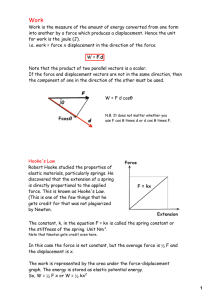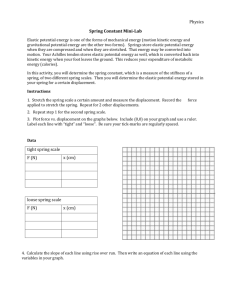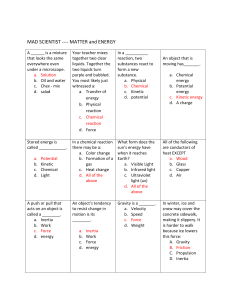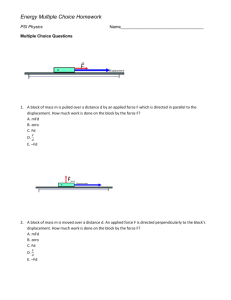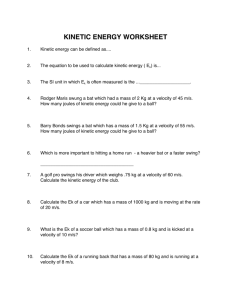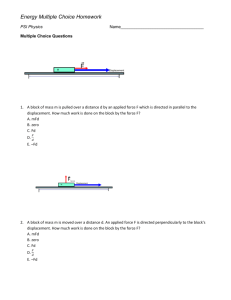Spring Constant Lab Report: Hooke's Law & Energy
advertisement
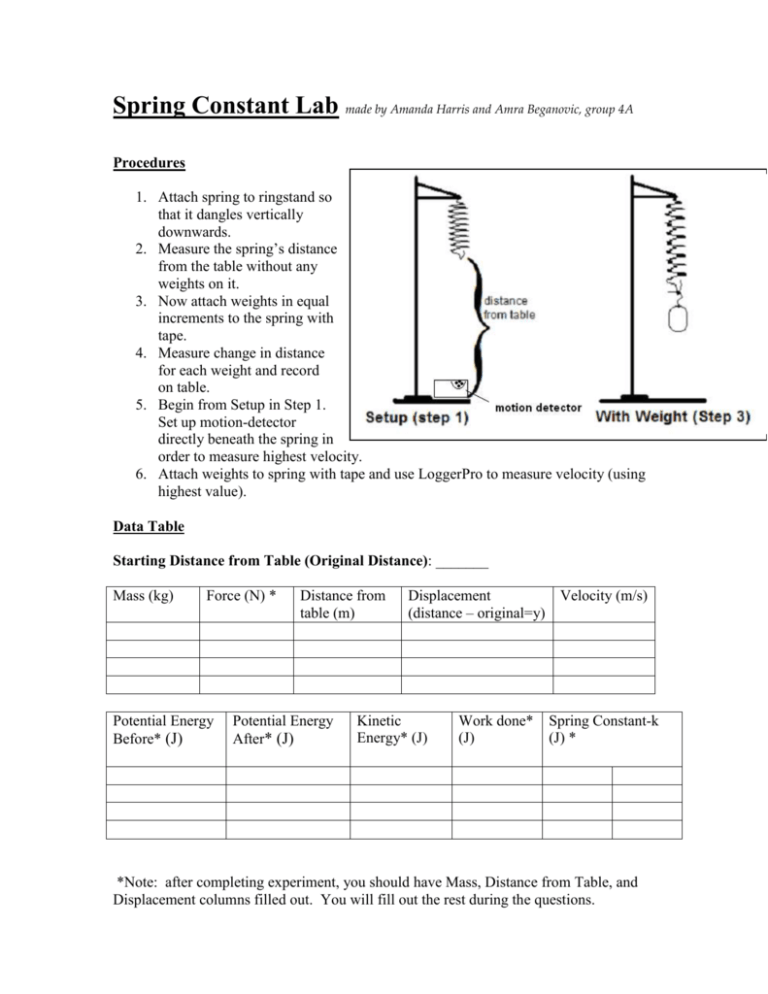
Spring Constant Lab made by Amanda Harris and Amra Beganovic, group 4A Procedures 1. Attach spring to ringstand so that it dangles vertically downwards. 2. Measure the spring’s distance from the table without any weights on it. 3. Now attach weights in equal increments to the spring with tape. 4. Measure change in distance for each weight and record on table. 5. Begin from Setup in Step 1. Set up motion-detector directly beneath the spring in order to measure highest velocity. 6. Attach weights to spring with tape and use LoggerPro to measure velocity (using highest value). Data Table Starting Distance from Table (Original Distance): _______ Mass (kg) Force (N) * Potential Energy Before* (J) Distance from table (m) Potential Energy After* (J) Displacement Velocity (m/s) (distance – original=y) Kinetic Energy* (J) Work done* (J) Spring Constant-k (J) * *Note: after completing experiment, you should have Mass, Distance from Table, and Displacement columns filled out. You will fill out the rest during the questions. Questions: PART 1: SPRING EQUATION/HOOKE’S LAW 1. How many forces are working on the spring? What it is usually called? Calculate its value and record onto table under Force. Only one force is working on the spring and that is weight in the downwards direction. It is calculated by m*g. 2. Hooke's Law states that: F=-ky. Calculate for k (using weight as F and y as displacement) for all trials. Record onto table under Spring Constant. 3. Graph Force (weight) vs. Displacement (y). What does the slope of this graph represent? What are the units? The slope of the graph represents the spring constant. Its units would be N/m. PART 2: ELASTIC POTENTIAL ENERGY 4. Calculate the amount of potential energy within the system both before and after the weight is added. Record onto table. Should calculate using m*g*y for both values. The y-value should be the original distance from the table to calculate for before and the changed distance for the after. 5. Calculate how much Work was done (change in PE or KE) by the weights. Record onto table. Should calculate using formula Wnet=mg(yf -yi) or 1/2mvf2 – 1/2mvi2. 6. Using the velocity found on LoggerPro, calculate the kinetic energy of the spring. Record onto table. Should calculate by setting up equation 1/2mv2. Should also be the same with potential energy. 7. According to the Law of the Conservation of Energy is any energy lost when potential energy is converted into kinetic energy? Explain why or why not and relate to second data table. No. There are no retarding or nonconservative forces involved. This is why Work, KE and the difference between initial PE and final PE are (or should be) all the same. 8. If no energy is lost, what happens when work (kinetic energy) is done by the weight? Where would the potential energy come from? From the spring’s potential energy, also called elastic potential energy. 9. Another way to calculate a spring's constant is using the Elastic Potential Energy Equation, or elastic PE = ½*k*y2. Solve for k and record onto table. 10. How do your two spring constants compare? Should they be the same or different? Explain. The two spring constants should be very similar to each other, if not identical. They both represent the same value, but were solved for by different methods.


